Entries by Scott McPherson (423)
A bit humbled today....
After reading Mike Coston's Thanksgiving blog, I am a bit humbled and honored. He has posted an excellent entry that I cannot improve upon, and so I will not even try. Please check out this link and say a little prayer for those individuals listed who are trying so valiantly to beat down the threat of another pandemic.
I never thought my name would appear alongside Oxford, Webster, Webby, Leavitt and Osterholm. Not deserved, but deeply appreciated. I think the flublogosphere is making a tremendous difference in communicating ideas, facts, suppositions and advice. Happy to be here.
And for Crawford, Mike, Sharon, Henry, the Reveres, SophiaZoe, Greg and all the others, keep up the excellent work! We are making a difference.
Finally, for you, dear reader: thank you for taking the time to read my blogs. I hope to continue to bring you quality writing. let me know if I don't. And please, no matter where you are, have a Happy Thanksgiving! that means, above all, be thankful for the gifts God has given you. Because you never know when they can be taken away or lost forever. Hug your family and appreciate your friends.
http://afludiary.blogspot.com/2007/11/thanksgiving-roll-call-redux.html
Still more on adenovirus
An entire thread on the Website FluTrackers.com http://www.flutrackers.com/forum/showthread.php?t=41234 bears reading and absorbing. The data seem to be pouring in now on adenovirus, especially ad14, the most interesting subtype. Follow this thread and download and read the medical texts.
Apparently, as Dr. Henry Niman and others have observed, this adenovirus is a recombining fool of an organism. Co-infections with up to three different types of adenovirus are not uncommon. And the virus has a foothold in other nations as well, including Egypt.
This situation bears very close watching. In some cases, the Case Fatality Rate for Ad14 approaches 25%. And testing for Ad14 is hardly ever done.
When I was associated with an IBM reseller, we learned one item from their lexicon: You don't know what you don't know. Clearly, we don't know the footprint of this virus, or how many people it actually infects, or how many times adenovirus has been misdiagnosed, or how many people it has actually killed and how many lives it has changed.
It is time to start finding out.
As Zoe's diary closes, another chapter opens in Africa
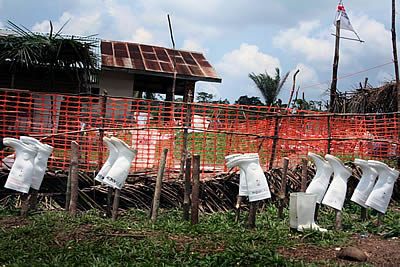 Doctors Without Borders healthcare worker Zoe Young is back home, freed from the ordeal of helping contain an outbreak of Ebola in the Democratic Republic of Congo. As you know, we were reading her diary intently in the first days of the containment process, alternately recoiling in horror, gasping at vivid descriptions and the primitive surroundings the MSF/DWB workers had to function in, and then sometimes even laugh at some of the goings-on at the camp.
Doctors Without Borders healthcare worker Zoe Young is back home, freed from the ordeal of helping contain an outbreak of Ebola in the Democratic Republic of Congo. As you know, we were reading her diary intently in the first days of the containment process, alternately recoiling in horror, gasping at vivid descriptions and the primitive surroundings the MSF/DWB workers had to function in, and then sometimes even laugh at some of the goings-on at the camp.
Zoe has finished her diary and is required reading for anyone who wants to understand what it is like to be the Boots On The Ground in situations like this. The photo is of MSF worker boots drying in the sun, not of lost colleagues.
Here is one snippet from her diary that I found particularly interesting and ironic (note the film they are watching).
22/10: Diary Day 20 - Tuesday
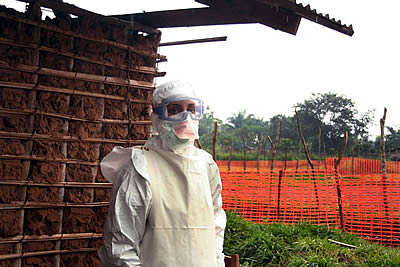 Today I went off to see the new baby Zoe. Her whole family was at home and everyone wanted to pose for photos. When I got back to the isolation unit the staff there were rather hurt that I hadn’t taken photos of them (I had, but not enough), so we had a photo session. When they posed they were all very serious, so I prodded them and bared my teeth in a manic smile to get them to smile back at me. I got some really good photos with their faces split wide open in big grins.
Today I went off to see the new baby Zoe. Her whole family was at home and everyone wanted to pose for photos. When I got back to the isolation unit the staff there were rather hurt that I hadn’t taken photos of them (I had, but not enough), so we had a photo session. When they posed they were all very serious, so I prodded them and bared my teeth in a manic smile to get them to smile back at me. I got some really good photos with their faces split wide open in big grins.
Isabel, Barbara, Henry, Jan and I went off to see some other springs to be improved. We had a fabulous walk past ponds where they are rearing Tilapia fish.
The first spring was very well organised. They had made a dam of sticks lined with big leaves and then filled with sand. The water came through in hollow bamboo pipes. The sand was wonderfully white and clean and the water was completely clear. If they dig they might be able to find some clay, which would make the dam a bit more resilient and need less maintenance.
The next spring is not going to be so easy to improve. There is nowhere to put a dam with pipes so that jerry cans can be filled up. At the moment it is a kind of sandy pond.
We watched another movie night tonight: “28 Days Later”. It’s all about a virus that is unleashed in the UK and results in everyone killing each other.
Well, firstly we knew that it should have been called “21 Days Later” if it was Ebola (the incubation time) but we let that go and settled down to watch. There were about 10 of us around one laptop. It was a very silly film and of course we shouted instructions at the screen about how to deal with projectile vomiting and blood everywhere and why weren’t they wearing goggles? Perhaps this could be a new job for me: advising on horror movies. http://www.msf.ca/blogs/ZoeY.php
Here's hoping Zoe gets plenty of rest, because she may be needed again soon.
Angola is experiencing a mystery illness, and it is felling people by the score. From the World Health Organization:
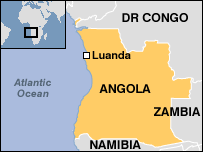 Unknown Illness in Angola
Unknown Illness in Angola
16 November 2007
An outbreak of a disease of unknown etiology is currently ongoing in Cacuaco municipality, Angola. The first cases were reported on 2 October. As of 15 November 2007, a total of 370 cases had presented for treatment at the Municipal Hospital in Cacuaco.
It is anticipated that additional unreported cases may be occurring within communities among patients preferring to remain at home or to receive treatment from traditional healers. The clinical symptoms of the disease are extreme drowsiness, waking only to painful stimuli. Patients recover slowly, over a number of days, but remain ataxic with many unable to walk unaided. The symptoms are most extreme in children.
The neurological indication is of a cerebellar abnormality with no sign of peripheral neuropathy. Reflexes are normal. The case presentation suggests a toxicological cause, however, the etiological agent has not yet been identified. Samples taken from patients have been tested for 300 organic solvents and a general drug screen covering 800 compounds has also been carried out.
These tests have so far proved negative. Tests for cadmium, lead, mercury and manganese have shown levels within the normal range. Environmental samples, as well as food and drinking water, have also been taken and results of tests are awaited.
Epidemiological investigations so far have not revealed a common source or route of exposure, and these investigations are now being extended in scope.
Angolan bug mystifies the experts
UN health experts say they remain mystified by an unidentified disease in Angola that has killed four people.
About 200 other victims are in hospital suffering from symptoms which include fever and extreme drowsiness.
A team of specialists has spent two weeks studying the outbreak at a clinic in a northern suburb of the capital.
The World Health Organization said it was important "people do not panic" and report to hospital if they have such symptoms, AFP news agency reports.
A WHO spokeswoman said experts were still carrying out tests.
"More and more people have fallen ill but we have not been able to identify the cause of their sickness," Reuters news agency quotes Fadela Chaib as saying at a news briefing.
"It might be exposure to a toxic substance, something in the environment. But the possibility of an infectious disease is not yet excluded."
The outbreak in Luanda's northern Cacuaco suburb was first reported in October.
Adenovirus returns to the headlines
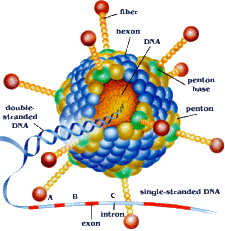 Last month, I blogged about the surge in cases of adenovirus -- especially the type known as Ad14. Today, Associated Press medical writer Mike Stobbe reports on the virus.
Last month, I blogged about the surge in cases of adenovirus -- especially the type known as Ad14. Today, Associated Press medical writer Mike Stobbe reports on the virus.
New cold bug kills 10, scores sickened
Scores sickened as mutated virus becoming more common, CDC says
ATLANTA - A mutated version of a common cold virus has caused 10 deaths in the last 18 months, U.S. health officials said Thursday.
Adenoviruses usually cause respiratory infections that aren’t considered lethal. But a new variant has caused at least 140 illnesses in New York, Oregon, Washington and Texas, according to a report issued Thursday by the U.S. Centers for Disease Control and Prevention.
The illness made headlines in Texas earlier this year, when a so-called boot camp flu sickened hundreds at Lackland Air Force Base in San Antonio. The most serious cases were blamed on the emerging virus and one 19-year-old trainee died. (bold mine)
“What really got people’s attention is these are healthy young adults landing in the hospital and, in some cases, the ICU,” said Dr. John Su, an infectious diseases investigator with the CDC.
There are more than 50 distinct types of adenoviruses tied to human illnesses. They are one cause of the common cold, and also trigger pneumonia and bronchitis. Severe illnesses are more likely in people with weaker immune systems.
Some adenoviruses have also been blamed for gastroenteritis, conjunctivitis and cystitis.
There are no good antiviral medications for adenoviruses. Patients usually are treated with aspirin, liquids and bed rest.
In the CDC report, the earliest case of the mutated virus was found in an infant girl in New York City, who died last year. The child seemed healthy right after birth, but then became dehydrated and lost appetite. She died 12 days after she was born.
Tests found that she been infected with a form of adenovirus, called Ad14, but with some little differences, Su said.
More common
It’s not clear how the changes made it more lethal, said Linda Gooding, an Emory University researcher who specializes in adenoviruses.
Earlier this year, hundreds of trainees at Lackland became ill with respiratory infections. Tests showed a variety of adenoviruses in the trainees, but at least 106 — and probably more — had the mutated form of Ad14, including five who ended up in an intensive care unit. (bold mine)
In April, Oregon health officials learned of a cluster of cases at a Portland-area hospital. They ultimately counted 31 cases, including seven who died with severe pneumonia. The next month, Washington state officials reported four hospitalized patients had the same mutated virus. One, who also had AIDS, died.
The Ad14 form of adenovirus was first identified in 1955. In 1969, it was blamed for a rash of illnesses in military recruits stationed in Europe, but it’s been detected rarely since then.
But it seems to growing more common. The strain accounted for 6 percent of adenovirus samples collected in 22 medical facilities in 2006, while none was seen the previous two years, according to a study published this month in the medical journal Clinical Infectious Diseases.
My earlier blog can be found at: http://www.scottmcpherson.net/journal/2007/10/11/its-not-always-influenza-that-kills.html . Stobbe's article can be found (among numerous other places) at: http://www.msnbc.msn.com/id/21820799/ .
Adenovirus is but one member of the new vanguard of older diseases coming back for a remake in the Information Age. last month, Reuters also picked up on the adenovirus outbreaks across the Americas. The story is below and can be found at:http://www.msnbc.msn.com/id/21269732/
Old virus causing new disease in United States
WASHINGTON - A strain of virus best known for causing colds and "stomach flu" is becoming more common and more dangerous, U.S. researchers report.
They said that adenovirus 21 was surprisingly common and was causing an unexpected level of severe disease and deaths.
The researchers used a new test developed by the U.S. Centers for Disease Control and Prevention and said the wider use of such tests might help doctors and health officials better understand what diseases are making people sick.
"It makes the case that if you did survey regularly and routinely for adenoviruses you would get more information and a little advance information on where the bad ones are likely to pop up and to be ready," said Dr. Catherine Laughlin of the National Institute of Allergy and Infectious Diseases, which paid for the study.
Adenoviruses cause colds, bronchitis and stomach upsets, but can also cause chronic airway obstruction, a heart infection called myocarditis, a sometimes deadly bowel condition called intussusception and sudden infant death at birth.
Gregory Gray of the Center for Emerging Infectious Diseases at the University of Iowa and colleagues were trying to get a handle on which types of adenoviruses were most common and which were causing serious outbreaks of disease.
This had not been easy to do because the old diagnostic tests were slow and could not differentiate easily among the different strains of adenovirus. And doctors rarely test patients to see what infection they have. (bold mine)
"The new test is very elegant and specific," Laughlin said in a telephone interview.
Gray's team used the test on 2,200 samples from 22 U.S. medical facilities, including eight military sites. Military personnel are especially susceptible to outbreaks of all kinds of disease, including adenoviruses.
Adenovirus 21 was found in 1 percent of specimens in 2004, but in 2.4 percent in 2006. And it was making people much sicker than the other strains, killing 50 percent of bone marrow transplant patients, for instance.
These patients are at extra risk from infections as their entire immune systems are destroyed before they get transplants of new bone marrow tissue.
"For both populations, we observed a statistically significant increasing trend of adenovirus type 21 detection over time," Gray and colleagues wrote in their report.
And half of them were sick enough to be hospitalized.
"The high prevalence of hospitalization among the patients with adenovirus infection was surprising," Gray's team wrote in their report, published in the journal Clinical Infectious Diseases.
Laughlin said the test would need to be commercialized, but having it available might encourage companies to develop better drugs and vaccines against adenoviruses.
"I think there will also be more effort in drug and vaccine development, especially because the numbers of immunosuppressed people that we have around really has been increasing," she said -- including cancer patients, organ recipients and people infected with the AIDS virus.
The Department of Defense has also contracted for a new vaccine against adenovirus types 4 and 7.
Like MRSA, typing for adenovirus should become manadatory. Too often tests are done and causes excluded; when will our testing include looking for certain re-emerging viruses? And like H5N1 overseas, we can assume the numbers of people who actually suffer from adenovirus infections is much greater than was has been reported. Recall that MRSA now kills more people in the United States than HIV/AIDS. If we really knew the numbers of people suffering from MRSA, adenovirus and other maladies, we would have much better surveillance on these emerging diseases.
Smoking gun found in wildfowl's webbed feet re: Suffolk H5N1 outbreak
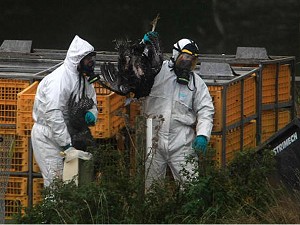 Dr. Henry Niman has a very thorough analysis of the Suffolk H5N1 outbreak. Titled Phylogenetic Analysis of H5N1 in Suffolk England, Dr. Niman reveals that the Qinghai strain found at the Redgrave Park Farm is a veritable match for the German and Czech substrains of Qinghai (Clade 2.2) H5N1 that were typed this past summer.
Dr. Henry Niman has a very thorough analysis of the Suffolk H5N1 outbreak. Titled Phylogenetic Analysis of H5N1 in Suffolk England, Dr. Niman reveals that the Qinghai strain found at the Redgrave Park Farm is a veritable match for the German and Czech substrains of Qinghai (Clade 2.2) H5N1 that were typed this past summer.
With this disclosure, it is Game, Set and Match (so to speak) for wild bird contamination of the free range farm. But now, of course, the culling has widened to include some 22,000 turkeys, geese and ducks. The same workers who managed and maintained the Redgrave operation also operated and maintained three other poultry farms in the immediate area. Those birds, too, will be culled as a precaution. This is also because the authorities suspect lax biohazard protocols, and are not willing to take any chances.
The effect of the cull includes a pre-holiday rush for Christmas and holiday poultry, especially turkeys and geese. Orders are streaming in to British storekeepers from families, who are worried there will not be enough holiday fowl to go around this Christmastime.
The analysis can be found at: http://www.recombinomics.com/News/11140701/H5N1_Suffolk_Phylogeny.html
